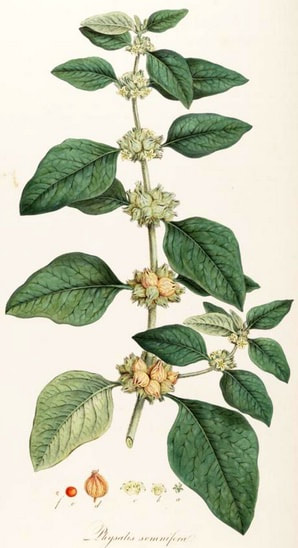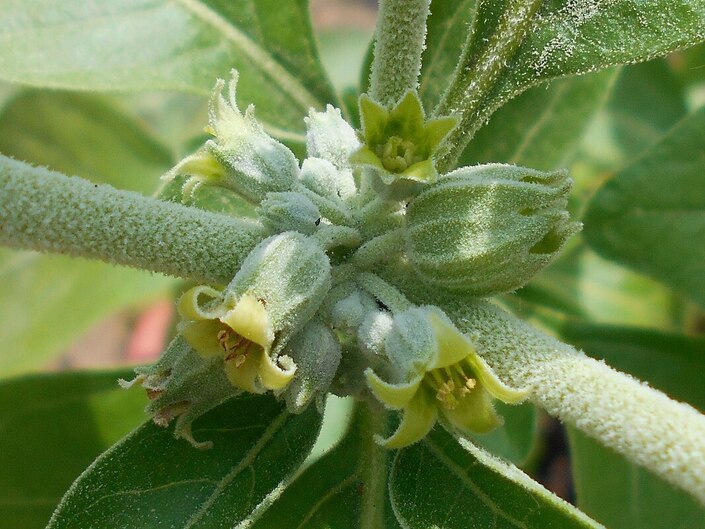Flora Graeca, Sibthrop, Smith, 1819
Withania root (Adam, 2019)
Botanical name:
Withania somnifera (syn. Physalis somniferum)
Parts used:
Root
Temperature & Taste:
Warm, neutral in respect of moisture. Sweet
Classification:
3H. LACTAGOGUE 3I. APHRODISIACS 3J. INCREASE SEMEN
N. Tonics
Withania somnifera (syn. Physalis somniferum)
Parts used:
Root
Temperature & Taste:
Warm, neutral in respect of moisture. Sweet
Classification:
3H. LACTAGOGUE 3I. APHRODISIACS 3J. INCREASE SEMEN
N. Tonics
Uses:
1. Tonifies the Spleen, Increases Qi:
-Fatigue, Poor Appetite, poor Digestion, weakness
-growth promoter in children
-enhances Immunity and increases disease resistance
-adjunct in many chronic diseases including Rheumatism and Arthritis, Hepatitis, AIDS.
2. Warms and Strengthens the Kidneys:
-Aphrodisiac; Impotence
-Male and Female Sterility (taken for several days following menstruation).
-Premature Aging and Senility; Neuro-degenerative diseases, Parkinson's, Dementia etc.
3. Regulates Qi, Calms the Mind:
-Nervousness, Irritability, Alcoholism
-Anxiety, mild Depression; Mental Illness including Schizophrenia
-Insomnia associated with Stress.
4. Moves the Blood, Clears Wind-Damp, Resolves Swellings:
-Scrofula, Rheumatism and Tumors
-auxiliary in Cancer treatment; benefits immunity and has direct anti-cancer activity against various Cancer cell lines
5. Resists Poison:
-Traditionally used in Scorpion sting.
6. Benefits Sight:
-strengthens the Sight (combined with suitable ingredients)
7. Externally:
-applied to obstinate Ulcers and Rheumatic Swellings.
-Scrofula and glandular swellings, apply a paste of the fresh green root made into a paste with cow urine or warm water.
-in various skin diseases, the powdered root is mixed with oil and applied.
-a paste is made with milk to apply to the breasts to keep their shape
-powder is mixed with milk and applied to sagging breasts
-externally, the oil is applied to promote growth of the penis
-also used to restore a relaxed vagina
ADVERTISEMENT:
Dose:
Powder: 500mg–6 grams;
Correctives:
... available in PRO version
Substitutes:
... available in PRO version
Powder: 500mg–6 grams;
Correctives:
... available in PRO version
Substitutes:
... available in PRO version
Main Combinations:
General Tonic:
1. Debility, Weakness, Emaciation, Digestive debility:
i. Withania with ... available in PRO version
ii. Withania with ... available in PRO version
iii. Withania, ... available in PRO version
2. Immune deficiency:
i. Withania with ... available in PRO version
ii. Withania with ... available in PRO version
iii. Withania with ... available in PRO version
iv. Withania, ... available in PRO version
v. Withania with ... available in PRO version
Nerve and Brain Tonic:
3. Nerve disorders with deficiency and aggravated Wind:
i. Withania with ... available in PRO version
ii. Withania, ... available in PRO version
4. Tonic for Wind disorders:
i. Withania, ... available in PRO version
ii. Withania, ... available in PRO version
iii. Withania, ... available in PRO version
iv. Withania, ... available in PRO version
5. Brain tonic:
i. Withania, ... available in PRO version
ii. Withania, ... available in PRO version
iii. Withania, ... available in PRO version
iv. Withania with ... available in PRO version
v. Withania, ... available in PRO version
vi. for the aged, Withania with ... available in PRO version
vii. Withania with ... available in PRO version
6. Tonic for those studying or doing excess mental work:
i. Withania with ... available in PRO version
ii. Withania with ... available in PRO version
iii. Withania with ... available in PRO version
7. To enhance Memory:
i. Withania with ... available in PRO version
ii. Withania, ... available in PRO version
iii. Withania with ... available in PRO version
iv. Withania, ... available in PRO version
v. Withania, ... available in PRO version
Reproductive Tonic:
8. As a strengthening tonic, for Impotence, Infertility and Senility:
i. mix Withania with ... available in PRO version
ii. Withania with ... available in PRO version
iii. Withania, ... available in PRO version
iv. Withania with ... available in PRO version
9. Reproductive tonic, for Males:
i. Withania, ... available in PRO version
ii. Withania, ... available in PRO version
iii. Withania with ... available in PRO version
iv. Withania with ... available in PRO version
v. Withania with ... available in PRO version
vi. Withania with ... available in PRO version
10. Reproductive tonic, for Females:
i. Withania with ... available in PRO version
ii. Withania with ... available in PRO version
iii. Withania with ... available in PRO version
iv. Withania with ... available in PRO version
v. Withania with ... available in PRO version
11. Female Infertility:
i. Withania, ... available in PRO version
ii. Withania with ... available in PRO version
12. To promote Breast development:
i. ... available in PRO version
ii. To tone and firm the breasts, ... available in PRO version
13. As an Aphrodisiac:
i. Withania with ... available in PRO version
ii. Withania with ... available in PRO version
iii. Withania with ... available in PRO version
iv. Withania with ... available in PRO version
v. Withania with ... available in PRO version
vi. Withania with ... available in PRO version
14. To increase Sperm:
i. Withania ... available in PRO version
ii. Withania with ... available in PRO version
iii. Withania with ... available in PRO version
iv. Withania with ... available in PRO version
v. Wiathnia, ... available in PRO version
15. Spermatorrhea:
i. Withania with ... available in PRO version
ii. Withania with ... available in PRO version
iii. Withania with ... available in PRO version
Childrens Tonic:
16. Tonic for Children
i. Withania, ... available in PRO version
ii. Withania, ... available in PRO version
iii. Withania, ... available in PRO version
iv. Withania ... available in PRO version
17. Childhood nutritional impairment with fever, poor appetite, Withania with. ... available in PRO version
Arthritic disorders
18. Arthritis, Rheumatoid Arthritis:
i. Withania with ... available in PRO version
ii. Withania with ... available in PRO version
iii. Withania with ... available in PRO version
iv. Withania, ... available in PRO version
v. Withania, ... available in PRO version
vi. Withania with ... available in PRO version
vi. Withania with ... available in PRO version
vii. Withania with ... available in PRO version
19. Cervical spondylosis:
i. Withania with ... available in PRO version
ii. Withania with ... available in PRO version
iii. Withania with ... available in PRO version
Other:
20. Polycystic Ovary Syndrome (PCOS):
i. ... available in PRO version
ii. Withania, ... available in PRO version
21. Scrofula, Withania, ... available in PRO version
22. Fibromyalgia, Withania, ... available in PRO version
Major Formula:
Balivivan (Ayurveda)
Dhatuvallabha Churna (Ayurveda)
Gso Byed 6 Pa of Tibetan Medicine)
Cautions:
Generally Safe.
1. Caution in excess Heat or Bile, and for those with congestion ('ama')
2. While it is used as a tonic for mother and fetus during pregnancy, this is only in compound; full doses of the single herb should be avoided. It is recommended not to take more than 3 grams daily during pregnancy.
3. Large doses are narcotic
Main Preparations used:
Generally Safe.
1. Caution in excess Heat or Bile, and for those with congestion ('ama')
2. While it is used as a tonic for mother and fetus during pregnancy, this is only in compound; full doses of the single herb should be avoided. It is recommended not to take more than 3 grams daily during pregnancy.
3. Large doses are narcotic
Main Preparations used:
ADVERTISEMENT:
Click the Tabs above for more information on this Medicine
|
'This plant bears the Sanskrit names of Asvagandha, Turagi or Turangi, and Turagi-gandha, "smelling like a horse or mare"; Varaha-karni, "boar-eared"; Vrisha, "amorous," &c. It is described in the Nighantas as tonic, alterative, pungent, astringent, hot and aphrodisiac, and is recommended in rheumatism, cough, dropsy, consumption and senile debility. Chakradatta recommends it in decoction with long pepper, butter and honey in consumption and scrofula. A ghrita or medicinal butter prepared by boiling together one part of the root with one part of clarified butter and ten of milk may be used in such cases.
As an aphrodisiac and as a remedy for rheumatism the drug is usually combined with a number of aromatics, each dose contains about 30 grains of the root. It is also made into a paste with aromatics for local application in rheumatism. Indian Mahometan writers merely repeat what the Hindus say about this drug, and do not recognise in it the Kaknaj-el-manoum of the Arabs, which is supposed to represent the [?] of the Greeks, the description of which by Theophrastus agrees tolerably well with W. somnifera. Rheede calls it Pevetti, and states that a vulnerary ointment is prepared from the leaves. Prosper Alpinus (i., cap. 33) describes and figures it under the name of Solanum somniferum antiquorum, |
Roxburgh states that the Telinga physicians reckon the roots alexipharmic. Ainslie (ii. 14) says:— "The root as found in the medicine bazars, is of a pale colour, and in external appearance not unlike our gentian; but it has little sensible taste or smell, though the Tamool Vytians suppose it to have deobstruent and diuretic qualities, given in decoction to the quantity of about half a teacupful twice daily; the leaves moistened with a little warm castor oil, are a useful external application in cases of carbuncle." The authors of the Bombay Flora say that the seeds are employed to coagulate milk like those of W. coagulane. We have tried the experiment and find them to have some coagulating power.
The plant is very common along the shores of the Mediterranean, where it has always been reputed to be hypnotic. The properties of W. somnifera have recently been investigated by Dr. Trebut with regard to its reputation for hypnotic properties; he states that he has obtained an alkaloid from it which has hypnotic action and does not produce mydriasis. P. L. Simmonds (Amer. Journ. Pharm., Feb., 1891) states that the plant is employed at the Civil Hospital, Alger, as a sedative and hypnotic. (Pharmacographia Indica, Dymock, 1891) |






